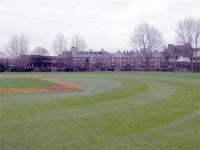April cricket diary at the County Ground Shrewsbury
April cricket diary at the County Ground Shrewsbury
By Wayne Lumbard

With now just a week away from my first game at the county ground, we still have a lot to complete after the recent cold spells, rain and heavy dew's.
We will mow the rest of the square once a week to 15mm to keep it in check and continue to thin out the sward, we will verticut the square on a fortnightly basis for the rest of the season. The squares are in excellent condition all though with the recent weather a bit too soft. But with the weather hopefully drying up we will continue the heavy rolling leading up to the first game of the season, always finishing in the direction of play from wicket to wicket.
Not as much rolling has been done as I would have liked and for the last 10 days or so the wicket has been to wet to roll, so best to keep off. We will continue to sorrel roll the squares on a fortnightly basis to relieve surface tension from all the rolling and allow the soil to breath and have somewhere for the water, fertilizer and other treatments to reach the soil profile.
During April, I will fertilise with Scotts 14.2.7. feed, or an A.L.S 15.0.6. liquid feed, all this depends on the fixture list and the weather, to help the soil life organisms I also apply a Vitax seaturf bio-stimulant. This acts as a source of food for the soil-life to do their job. Three applications through out the season I feel is enough.
I still have got to square off both my squares, and measure in the 20 wickets. I make sure that all measurements are precise and accurate, no room for error on this task. Marking out the boundary lines, I use the same pa
I continue to mow the outfield with our 36" Dennis mower, collecting the clippings and lightly rolling to achieve a true surface. Now that the football has finished we will walk the whole of the outfield repairing/replacing divots, land scars and any other minor undulations. We are reseeding and dressing out goal mouths on the edge of the outfield.
We have now finished renovating the 3 ends that we aimed to do in the winter, and these will have a whole season to establish before they will be used next year. With so many games played most nights of the week we really have very little time for match preparation. It normally means that every morning I'm preparing a wicket(s) for that nights play and repairing wicket(s) from the previous nights play. But we maximise the time we have and do what we can to achieve the highest standard possible.
Wicket preparation
1. Mark out the wicket (10ft wide) using strings to create straight lines.
2. Swish/brush the wicket.
3. Walk wicket, lifting any ball marks/scuffs etc.
4. Mow the wicket twice using a 5 bladed mower at two different heights of cut.
5. We verticut the wicket twice to thin out the sward as much as possible to remove lateral growth and help to reduce crowning, making sure we do not scar the surface.
6. I then mechanically brush the wicket to remove any debris from mowing or verticutting etc.
7. I then double mow using a 9 bladed cylinder to 5mm as my final cut of the wicket.
8. Walk and check the surface of the wicket again.
9. I then roll the wicket for approx 30/40 minutes before the game.
10. Finally marking out the ends, making sure all markings are current, straight and brightly painted. Presentation is everything.
Repairing the wicket after play.
1. Walk the wicket and the whole square, lift any ball marks/scuffs, indents etc.
2. Sweep out by hand using a dust pan and brush all foot holes, to create a clean surface to repair to.
3. We then mechanically sweep the whole wicket 2/3 times until all debris from the game has been cleared off.
4. I then mow the wicket to finally clean the sward.
5. Then using a seep hose the full length of the wicket we flood the wicket to a point where the water is lying on the surface.
6. When the water has disappeared through the surface, I then sorrel roll the whole wicket.
7. Then we soak the foot holes separately after making fork holes in the bottom, this allows water to penetrate and the new loam to key in the surface.
8. When excess water is gone we fill in the holes with a pre-prepared loam in a damp state, and using a thumper to level the hole true to the surface. The rest of the crease will have a light dusting of topdressing truluted in.
9. Both ends and the track itself will get an over seeding where necessary using at least a seed mix with 55/65% Ryegrass mix.
With the amount of games played this wicket will have to be ready in approximately 10 days. All this depends on the quality of the repair work, we also keep the ends wet or at least don't allow the loam to dry out or all your hard work will be lost and become just loose dust which is no good in foot holes. All we need now is some nice sunshine ready for Sunday, but more likely rain, hail and freezing cold. Have a good start to your season and remember we can not please everyone, but it's the Groundsman that knows best!
